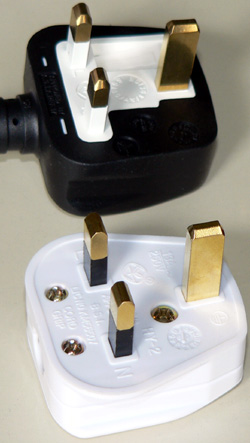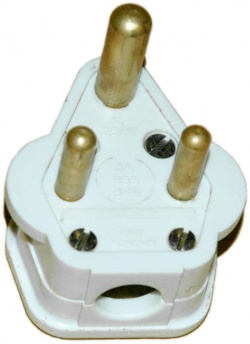Difference between revisions of "Mains plug"
(→See also: link to fuse) |
|||
| (2 intermediate revisions by the same user not shown) | |||
| Line 2: | Line 2: | ||
==BS 1363 13A Mains Plug== | ==BS 1363 13A Mains Plug== | ||
| − | Generally regarded as the safest mains plug in common use in the world today (unless you tread on an upturned one that is!), the standard British mains plug has a number of unique features and design aims. The plug is one of few designs that include an internal fuse. This | + | Generally regarded as the safest mains plug in common use in the world today (unless you tread on an upturned one that is!), the standard British mains plug has a number of unique features and design aims. The plug is one of few designs that include an internal [[fuse]]. This means the Fuse/[[MCB]] for the whole circuit does not also have to provide fault protection for the appliance [[flex]]. Freed from this limitation, the result is that UK power circuits can be protected at a substantially higher current than one appliance can consume, and hence can have much more capacity than most other designs (32A or > 7.3kW continuous load). |
| − | Other key features include | + | Other key features include sockets with safety shutters - preventing items being poked into the socket and gaining access to the live terminals when the plug is withdrawn. |
[[image:Moulded and rewireable BS 1363 plugs.jpg|Examples of rewireable, and moulded on plugs]] | [[image:Moulded and rewireable BS 1363 plugs.jpg|Examples of rewireable, and moulded on plugs]] | ||
| − | |||
==BS 546 2 and 3 pin plugs== | ==BS 546 2 and 3 pin plugs== | ||
| − | + | Now no longer commonly used, some of these older designs of UK plug may still be legally used (sockets must now be shuttered), and are sometimes found in niche applications. The large 15A 3 pin version being used for things like stage lighting (where the lack of a fuse is considered helpful since there is less chance of it being damaged by rough treatment, and the physical incompatibility prevents non lighting equipment being connected to dedicated controlled lighting circuits). | |
| − | The smaller 2 and 5A versions are useful for | + | The smaller 2 and 5A versions are useful for [[lighting]] sockets in the home - allowing table lamps to be centrally switched or dimmed, or providing a fixed connection point for under cupboard lighting in [[kitchen]]s that can be installed as a part of the [[Cable|fixed wiring]] rather than needing to wait for the installation of the cabinets. |
[[image:BS-546-3-pin-plugs-4.jpg|250px]] | [[image:BS-546-3-pin-plugs-4.jpg|250px]] | ||
Revision as of 06:52, 10 October 2017
An introduction to the various mains plugs used in the UK.
BS 1363 13A Mains Plug
Generally regarded as the safest mains plug in common use in the world today (unless you tread on an upturned one that is!), the standard British mains plug has a number of unique features and design aims. The plug is one of few designs that include an internal fuse. This means the Fuse/MCB for the whole circuit does not also have to provide fault protection for the appliance flex. Freed from this limitation, the result is that UK power circuits can be protected at a substantially higher current than one appliance can consume, and hence can have much more capacity than most other designs (32A or > 7.3kW continuous load).
Other key features include sockets with safety shutters - preventing items being poked into the socket and gaining access to the live terminals when the plug is withdrawn.
BS 546 2 and 3 pin plugs
Now no longer commonly used, some of these older designs of UK plug may still be legally used (sockets must now be shuttered), and are sometimes found in niche applications. The large 15A 3 pin version being used for things like stage lighting (where the lack of a fuse is considered helpful since there is less chance of it being damaged by rough treatment, and the physical incompatibility prevents non lighting equipment being connected to dedicated controlled lighting circuits).
The smaller 2 and 5A versions are useful for lighting sockets in the home - allowing table lamps to be centrally switched or dimmed, or providing a fixed connection point for under cupboard lighting in kitchens that can be installed as a part of the fixed wiring rather than needing to wait for the installation of the cabinets.

